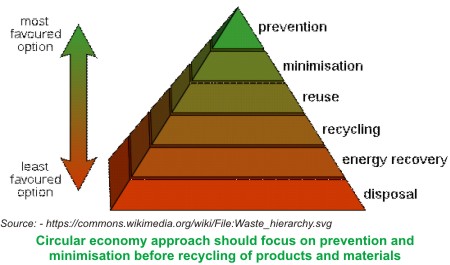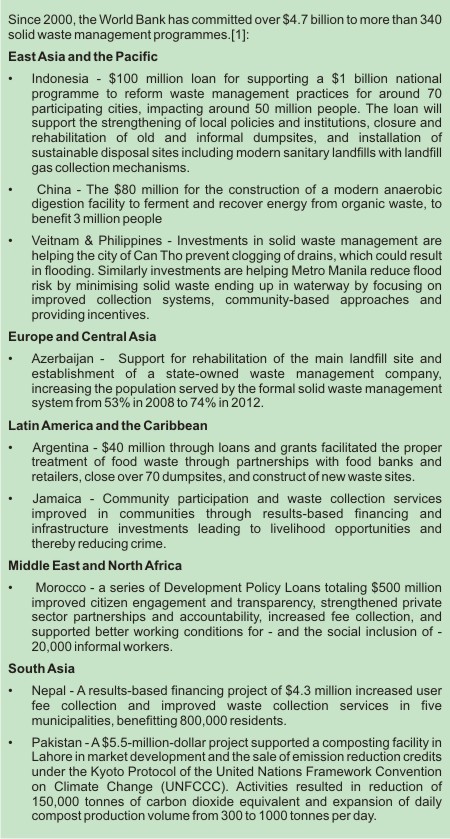SDG s Focus on Prevention, Reduce, Reuse and Recycle
In
this fast-paced world, trash is being produced at incomprehensible rates. In
this race, we are getting wasted!
Around the world, waste generation rates are accelerating. In 2016, the
world's cities generated 2.01 billion tonnes of solid waste, amounting to a
footprint of 0.74 kilograms per person per day. With rapid population growth
and urbanisation, annual waste generation is expected to rise by 70% from
2016 levels to 3.40 billion tonnes in 2050.1 As per a World Bank
report, the amount of urban waste being produced is growing faster than the
rate of urbanisation. By 2025 there will be 1.4 billion more people living
in cities worldwide, with each person producing an average of 1.42 kg of
waste.2

Urban poor are severely affected by lack of proper waste management. In low-income countries, over 90% of the waste is often disposed in unregulated dumps or openly burned. These practices result in serious health, safety and environmental hazards. Poorly managed waste dumps become a breeding ground for disease vectors; add to global climate change through methane generation, contaminate air, soil and water and encourage urban violence. By 2025, about 10 per cent of the global greenhouse gas emissions will be from waste landfills if no action is taken. Significant methane emissions from waste dumps contribute to global warming and can lead to violent explosions.
There have been incidents around the world
involving landfills. On 14 April 2017, while Sri Lanka was celebrating its
traditional new year when a mountain of waste lying on the north-eastern
edge of Colombo collapsed resulting in a landslide which buried 145 homes,
claiming 30 lives. On 22 August 2017, in Conakry, the capital of Guinea, 8
people were killed and dozens injured when a similar waste heap landslide
occurred. In a like incident in New Delhi on 01 September 2017 two people
died and several got injured. All these accidents followed heavy rainfall
that de-stabilised vast mountains of waste.3

We cannot ignore sustainable waste management. It is one of the prime needs for building liveable cities. Despite this recognition, it still remains a huge challenge for a major part of the world. Producing waste might be easy but its management is expensive. The World Bank estimates that global waste management costs will rise from US$ 205 billion per year in 2010 to US$ 305 billion by 2025.4 As per Sustainable Development Goal (SDG) 9 which states ‘build resilient infrastructure, promote inclusive and sustainable industrialisation and foster innovation’ and Goal 11 which states ‘make cities and human settlements inclusive, safe, resilient and sustainable’; we need to take care of waste management in such a manner that it does not lead to further social and ecological consequences. The waste which does not perish organically, needs to be treated not just to be able to get rid of it but also to put it in a reusable form – concept of waste to wealth. It literally means converting waste from exhausted utility to something of value.
Waste mountains which appear as a threat to us today are actually unrecognised treasures which are constantly demanding our attention. “About 3.6 million tonnes of municipal solid waste is produced every day around the world. If we could convert it all, the waste generated daily could produce energy equivalent of 3 million barrels of oil per day or could support 178 gigawatts of electricity production. Advanced thermal treatment methods can divert up to 98 per cent of solid municipal waste to recover energy – essentially eliminating the need for landfills,” said Richard Fish of AlterNRG (USA) quoted at 26th session of UNECE’s Committee on Sustainable Energy in Geneva.5 It can be both attractive and viable solution in a world where one in five people do not have access to clean electricity. It becomes all the important to recognise and adopt such solutions in the wake of SDG 7 on providing clean and affordable energy for all by 2030.
It is important to have policies and guidelines carving at least a broad pathway as per the SDG’s in order to be able to meet the laid-out goals by 2030. Emphasis needs to shift from landfills to boost recycling and recovery.
Currently within the global policy framework, waste services prominently feature in the targets and indicators of both SDG 11 and SDG 12. Within both the specified goals, the focus is to prevent, reduce, recycle and reuse – as well as to properly collect and discharge urban solid waste and halve global food waste by 2030, and to properly handle and treat chemical and other hazardous waste through the whole life cycle in accordance with international standards by 2020. They also figure under the transformative commitments made by UN Habitat member states in the 2016 New Urban Agenda (NUA), which pledges to realise universal access to sustainable waste management systems, minimise landfills and convert waste into energy, with special attention to coastal areas.6
Waste treatment can give a push for micro-enterprise development on a large scale and as well new livelihood opportunities through employment generation. Since only 26% of the paper waste gets recycled at present in India, there is a lot of scope in this field. Nearly 26 years back, TARA, the social enterprise wing of the Development Alternatives Group innovated the waste-to-wealth paper recycling technology to promote sustainable lifestyles through use of recycled products and create new livelihoods and jobs through enterprise development. TARA Papermek technology is the only technology that can recycle waste of denim and Tetra Pak on a micro or small scale. TARA has commissioned more than 300 recycling enterprises across India. Encouraging such initiatives needs to feed truly into all-inclusive plan encompassing the participation of all waste workers, be they formal (public and private) or informal, along with their existing unions and associations; as well as of service users from all concerned neighbourhoods and communities, including those in disadvantaged areas and slums. ■
Jyoti Sharma
jsharma@devalt.org
References
1. https://waste-management-world.com/a/interactive-map-worlds-most-wasteful-countries
2. https://waste-management-world.com/a/interactive-map-worlds-most-wasteful-countries
3. https://www.unece.org/info/media/news/sustainable-energy/2017/from-risk-to-resource-waste-can-contribute-to-sustainable-development/doc.html
4. http://www.worldbank.org/en/topic/urban development/brief/solid-waste-management
5. https://www.unece.org/info/media/news/sustainable-energy/2017/from-risk-to-resource-waste-can-contribute-to-sustainable-development/doc.html
6. https://www.2030spotlight.org/en/book /1730/chapter/sdg-11-ensure-sustainable-waste-services-we-must-value-waste-workers-and-make